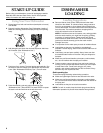
7
Loading Top Rack
The top rack is designed for cups, glasses, and smaller items.
Many items, up to 9 in. (22 cm), fit in the top rack. (See
recommended loading patterns shown.)
NOTE:
The features on your dishwasher rack may vary from the
drawings shown.
■
Place items so open ends face down for cleaning and
draining.
■
Load glasses and cups in top rack only. The bottom rack is
not designed for glasses and cups. Damage can occur.
■
Place cups and glasses in the rows between tines. Placing
them over the tines can lead to breakage and water spots.
■
China, crystal, and other delicate items must not touch each
other during dishwasher operation. Damage may occur.
■
Load plastic items in the top rack only. Only plastic items
marked “dishwasher safe” are recommended.
■
Load plastic items so the force of the spray does not move
them during the cycle.
■
To avoid chipping, do not let stemware touch other items.
■
Small bowls, pans, and other utensils can be placed in the
top rack. Load bowls in the center section for best stability.
Loading Bottom Rack
The bottom rack is designed for plates, pans, casseroles, and
utensils. Many items, up to 13 in. (33 cm) tall, fit in the bottom
rack. (See recommended loading patterns shown.)
NOTE:
The features on your dishwasher rack may vary from the
drawings shown.
■
Do not load glasses, cups, or plastic items in the bottom
rack. Load small items in the bottom rack only if they are
secured in place.
■
Load plates, soup bowls, etc., between tines.
■
Overlap the edges of plates for large loads.
■
Load soup, cereal, and serving bowls in the rack in a variety
of ways depending upon their size and shape. Load bowls
securely between the rows of tines. Do not nest bowls
because the spray will not reach all surfaces.
10 place setting
12 place setting
Cup and glass load
10 place setting
12 place setting
Utensil load


















